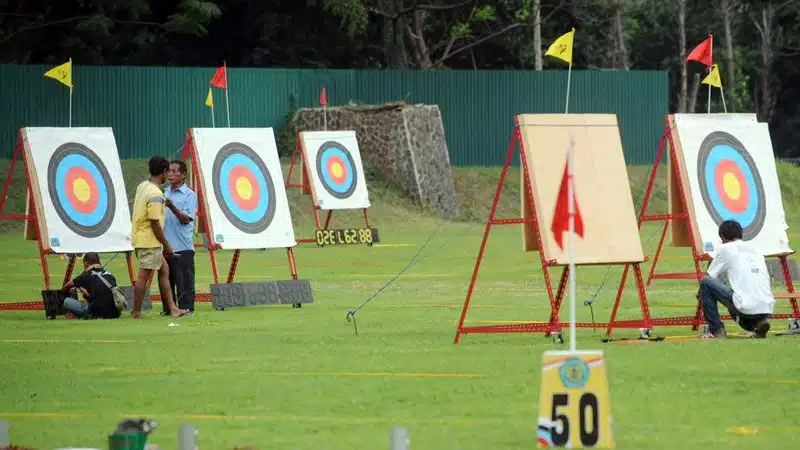
Sikkim, Meghalaya and Goa are the only Indian states apart from the union territory of Daman and Diu to regulate gambling in the country. While Sikkim was the first-ever entrant, Meghalaya only passed the bill to regulate gambling last year.
Way before that though, there was only one form of gambling that the state government had authorized and it is still responsible for lakhs of rupees flowing around the capital city of Meghalaya, Shillong.
What hooked the people of this small northeast hill station was a game of archery that they call ‘Teer’ (Arrow) with a slight twist based on the interpretation of the dreams of the bettors in question. Confusing, right? At first, it was for us too.
But before dwelling on how dreams have anything to do with betting, let’s understand how this traditional gambling game entrenched deep in Meghalaya culture and folklore works.
Teer - a game of luck and dreams in Meghalaya
Some 20 or so archers gather in a semi-circle to engage in a two-round battle consisting of five minutes. Their objective is to hit a bundle of straws which is about 50 meters away from them. The archers fire somewhere between 300 to 1000 arrows each round and by the end of the rounds, Teer officials proceed to count the number of arrows that have hit the straw.
As for the punters, their role sees them betting on how many arrows will hit the target. All they have to do is to pick a number between 0-99 that represents the final two digits of the number of arrows that have struck the target. For example, say 350 arrows have hit the bundle, then everyone who chose 50 will get a payout.
There are five types of bets that can be categorized as: single (0 to 9), house (10 to 19, 20 to 29 and so on), ending (last digit), and pair (11, 22, 33, 44). The last category is betting on the exact numbers in both rounds on a single day. It’s also worth mentioning that if someone correctly predicts the number in both rounds, it is called a fourcast, where the winning amount that the gambler wins is much higher.
It may seem to be solely a game of luck and chance but for the locals, it’s more of a tradition as they believe the winning numbers appear in their dreams that they later decipher before placing their bets.
"A corpse, doctor and a person wearing a police uniform would all indicate the number 9," a Nepali local, Loknath Khanna, who has been selling tickets at a Teer counter for 30 years was quoted by Edition.CNN.
“Similarly, a dog or a cow would mean the number 4,” he added.
A few more signs, symbols, indicators or interpretation of dreams as per TeerToday are as follows:
Quarrel between husband and wife: 03, 08, 13, 37, 40, 73
Erotic dream: 17, 40, 53, 59, 60, 83
Bathing in the open: 08, 18, 28, 48, 78, 98
Travelling: 08, 14, 18, 52, 64, 68, 74, 78, 98
Travelling in an aeroplane: 23, 43, 53, 63, 68, 73, 83, 93
Cow, goat or buffalo: 12, 18, 19, 22, 24, 34, 42, 54, 72, 74, 84, 94, 97
And there’s much more.
There’s no historical evidence of how the game evolved into betting, but it has become so popular that people from neighbouring states are now attracted to the tradition. In fact, its widespread popularity was perfectly depicted in Mrighdeep Singh Lamba’s film, Fukrey.
Now, we are not sure whether Fukhrey’s idea was adopted from the teer culture, but there are several similarities. For starters, two friends, namely, Choocha - played by Varun Sharma - and Hunny - played by Pulkit Samrat - are shown betting on lottery ticket numbers based on what the former had dreamt of the previous night.
Hunny then used to decode a number out of it to get a hefty payout.
Tax on tickets
Walking along the main market of Shillong will give a glimpse of how popular and commercialized teer has now become. After being legalized in 1982, every ticket seller is now paying a 10 per cent cut to the government apart from paying the archers and handling other operational costs.
"There are about 500 to 600 counters and an almost unlimited number of bookies in Shillong alone, where the bets can go up to Rs. 5 crores on a single day," a bookie in Shillong was quoted by Edition.CNN.
Mind you, these are not full-time archers. They only treat this game as an extra source of income and it is said that they earn between 300 to 500 rupee a day for about three hours of work.
The teer tradition, however, has witnessed a slight decline ever since the Meghalaya Cabinet decided to re-launch the state lottery in December 2019.
Despite that though, many have stayed connected with the game of teer as it is more than just a gamble. It’s a way of keeping a connection with one’s roots and traditions of the state which the locals certainly won’t let die down anytime soon.
Furthermore, Teer is more than simply gambling for the locals who view the activity as a mode of getting the entire community together. Old or young, the enthusiasm for Teer knows no bounds in Meghalaya.
It also helps as an additional source of income for the archers who generally come from remote villages in the state, making Teer more than just a gambling activity and if anything is a way of life for the people of Meghalaya.
Interested in sports betting? Click here to check out a list of top sites.
Author: Swapnil Bhopatkar
Featured photo: ADEK BERRY / AFP













